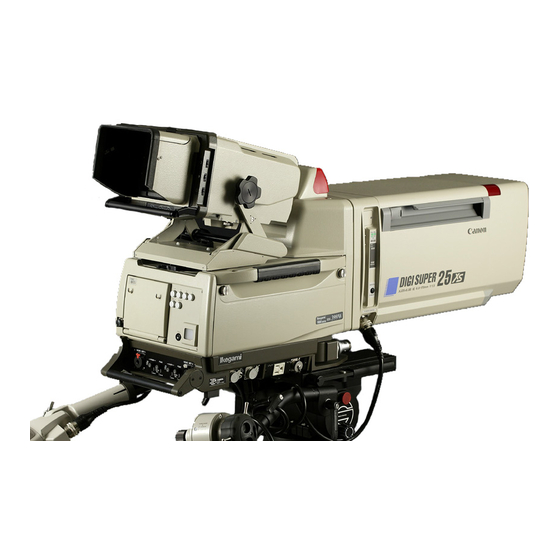Ikegami HK-388P Specificatie - Pagina 3
Blader online of download pdf Specificatie voor {categorie_naam} Ikegami HK-388P. Ikegami HK-388P 9 pagina's. Ultra-wideband studio/field digital ccd camera system

Combining Top Image Quality
with Production Creativity
The HK-388 and HK-388P deliver high resolution, low noise image quality with a wide
dynamic range and accurate color fidelity.
Due to the extensive use of digital circuits, top image quality is achieved in a consistent
and easy manner.
Also for production creativity, a wide range of state-of-the-art functions can be selected
to enhance the image quality.
High-Density CCDs
The HK-388 and HK-388P employ high-density 520,000
pixel 2/3-inch FIT CCD image sensors. The HK-388W
and HK-388PW employ newly developed 640,000 pixel
2/3-inch FIT CCDs. And HK-388Wi, employs 640,000
pixel 2/3-inch IT CCDs (switchable 16:9/4:3), and HK-
388PH, employs 640,000 pixel 2/3-inch FIT CCDs (4:3
fixed) are also available. In the studio cameras, the CCD
block is mounted on a bedplate with axis adjustment
assuring perfect optical alignment between zoom lens and
CCD sensor.
Instant Switching between 4:3 and 16:9
By command from the MCP or from the external system,
the camera will instantly convert between 4:3 and 16:9
aspect ratios. Camera video is converted by digital process
eliminating the need for re-calibration of analog circuits or
re-alignment of optical axis. The viewfinder automatically
follows the switching of the camera video.
New Level of Wide Screen Performance
The HK-388 and HK-388W, operating in 4:3, have the
same resolution performance. Owing to the 640,000 pixel
CCD, however, the 16:9 performance of the HK-388W
establishes a new higher level of performance with greater
modulation depth and true wide-screen angles-of-view.
New Super V
The New Super V mode for CCD operation allows the
vertical resolution to be increased in three increments from
400 to 480 TV Lines for frame capture and wide screen
applications, bridging the gap in vertical resolution
between conventional and high definition performance.
Extended Range Continuous Variable Speed
Shutter
This unique system for FIT CCDs permits variable shutter
operation above and below 1/60 second so the camera
can sync to slow scan or fast scan PC display monitors.
High shutter speeds, including continuously variable mode,
are also available for sports applications.
Flexible Filter System
Both studio and portable camera types include dual motor
driven 5-position optical filter wheels and electronic color
temperature correction so it is easy to satisfy production
requirements. Daylight color temperature can be corrected
electronically so optical filter positions are available for
combined filter effects.
True-to-Life Color Reproduction
The camera is equipped with a digital linear matrix circuit
for accurate colorimetry. For special applications the
standard colorimetry can be changed via six function
remote control of the linear matrix as well as the overall
Color Saturation remote control function.
Dual Knee System
Both Pre Knee and Digital Knee Circuits are incorporated
to handle a wide dynamic range maintaining faithful color
reproduction. The digital encoder includes Black Stretch
and Black Press to improve reproduction of high and low
contrast scenes.
Digital Detail Enhancement
Operating in the digital domain the DTL system provides
3-channel enhancement for uniform sharpness of all
colors. It includes conventional as well as new digital
functions not possible in analog DTL systems.
Diagonal DTL
Diagonal DTL derives an edge signal from the diagonal
components of the video signal to enhance resolution.
Not only horizontal and vertical edges are influenced by
the detail signal, but also diagonal edges. This key
function enables the HK-388 to provide a very natural
image impression which can not be obtained with
conventional cameras. With the Diagonal DTL function,
cross-color artifacts are reduced.
Slim DTL
Slim DTL reduces edge thickness without changing the
boost frequency of the edge signal. This permits a fine
edge which will not be attenuated by bandwidth limits in
the path to the home receiver.
Skin DTL
Skin DTL softens the facial complexions of the talent
while retaining the detail in the rest of the scene. The
AHD (Auto Hue Detect) function facilitates Skin DTL
adjustment to select a desired skin tone at the mere
touch of a switch.
DTL Boost Frequency
The boost frequency of the horizontal edge signal can
be shifted within the range of 3MHz to 8MHz.
Appropriate edge enhancement can be selected for
different applications and different scenes.
DTL B-W Balance
The balance of sharpness between dark and bright areas
can now be controlled by adding the DTL signal to
video both before and after gamma.
